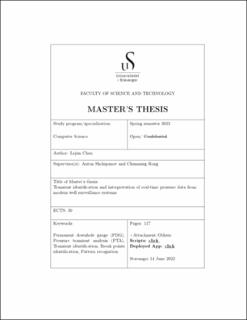| dc.description.abstract | Permanent downhole gauges (PDG) that are installed in modern wells are capable of
recording pressure and temperature data during well operations. These data in combination with flow rate measurements may be utilized for Pressure Transient Analysis (PTA) or its time-lapse version - time-lapse PTA. Unlike traditional PTA which would mainly interpret data from shut-in periods, time-lapse PTA is applied to sequential pressure transients and both flowing and shut-in periods to evaluate well-reservoir parameters that may vary with time. A PTA workflow may be divided into several steps. In this study, we mainly focus on the step of transient identification
based on pressure measurements, which is crucial for time-lapse PTA and
keeps being a challenge especially when the data are very noisy. Another step - denoising is also carried out and discussed in the part of computational experiments.
Previous work in the area of the transient identification has been studied before developing and testing of own algorithms to address this problem. Seven approaches have been reviewed, compared and summarized in the thesis.
In this master thesis, the transient identification problem is considered as a two-stage
process consisting of two identification tasks: 1) splitting the data set into shut-in
and flowing periods; 2) task 1 + detecting multi-rate break points in flowing
periods. Three methods based on pressure derivative, tangent of pressure data and pattern
recognition were proposed and studied and a workflow to implement these methods was designed.
Through a number of computational experiments, the derivative-based method provided the best result for the task 1, while tangent-based method - best results for the task 2. In the comparison section, we discussed the results of testing of these methods taking an insight into performance of the break-point detection in the different tasks.
The thesis is finalized by establishing an easy-to-use web application, where the
users could experiment with different methods using own data sets. The web app provides a friendly user interface to upload and test different data sets and download results of the break-point detection. | |
